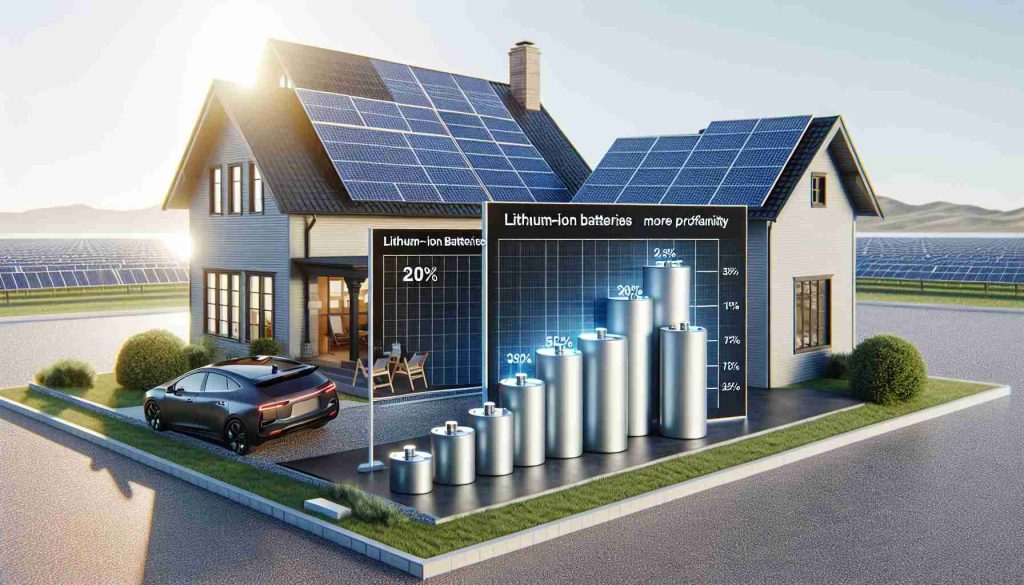Study Shows Lithium-Ion Batteries More Profitable than Hydrogen for Solar Homes – yTech
A recent study by Australian researchers has shed light on the debate between using hydrogen and lithium-ion batteries for energy storage in homes with rooftop solar panels. While both storage solutions offer benefits for solar energy systems, lithium-ion batteries appear to deliver better financial returns, whereas hydrogen batteries excel in longevity and capacity.
Summary:
Researchers from the University of New South Wales have analyzed the technical and economic efficiency of hydrogen and lithium-ion batteries in residential solar power setups. Their findings indicated that lithium-ion batteries, like Tesla’s Powerwall 2, are financially more beneficial in the short term, achieving quicker payback periods compared to hydrogen batteries, such as the LAVO system. On the flip side, hydrogen batteries offer superior lifespan and longer durations of energy storage, making them a solid choice for scenarios that prioritize longevity over immediate return on investment.
Lithium-ion batteries have become a popular choice for both residential and commercial energy storage, largely due to their relatively high roundtrip efficiencies and lower costs. Through detailed modeling of battery performance and deterioration, the study helped highlight the clear advantages and drawbacks inherent to each storage method.
The team’s analysis showed that the roundtrip energy losses of hydrogen batteries resulted in higher operational costs versus lithium-ion batteries. This implied higher payments to energy retailers and longer payback periods for hydrogen systems. Conversely, due to their higher energy densities and reduced capacity degradation over time, hydrogen batteries emerged as a viable option for situations where extended energy storage is crucial.
Ultimately, the decision between the two battery types for homeowners with solar panels may boil down to individual preferences, such as a willingness to trade off financial gains for larger energy storage potential or the need to cater to water availability when considering the water-intensive hydrogen generation process. The insight provided by this research highlights the complexity of choosing the right energy storage solution and the importance of tailoring systems to specific user needs and regional factors.
Industry Overview:
The energy storage industry, particularly for residential solar power systems, has been rapidly evolving with the growth of the renewable energy sector. The demand for efficient and cost-effective storage solutions has increased as more people seek to harness solar energy to reduce their carbon footprint and electricity costs. The two leading technologies in home energy storage have been lithium-ion batteries and, more recently, emerging hydrogen storage systems.
Market Forecasts:
The market for energy storage is expected to expand significantly in the coming years. According to industry analysts, the global lithium-ion battery market is projected to grow substantially, driven by its widespread use in electric vehicles, electronic devices, and stationary storage applications. On the other hand, the hydrogen energy storage market is also anticipated to gain momentum, especially as renewable energy generation increases and the need for long-duration storage solutions becomes more pressing. However, the market share and growth rate of hydrogen storage solutions may heavily depend on advancements in technology, cost reductions, and regulatory support.
Industry Issues:
While the study highlights the cost-effectiveness of lithium-ion batteries in the short term, the industry is not without challenges. Lithium-ion technology faces issues related to battery degradation over time, the environmental impact of sourcing materials like lithium and cobalt, and the need for end-of-life recycling processes. Hydrogen energy storage, although beneficial in terms of longevity and capacity, has hurdles regarding energy efficiency, infrastructure requirements, and the initial high investment costs. Furthermore, the production process for hydrogen can be water consumption-intensive, which may raise concerns in areas with limited water resources.
Additionally, safety considerations must be carefully managed for both technologies. Lithium-ion batteries pose risks related to thermal runaway events, whereas hydrogen systems must handle the challenges of pressurized storage and potential leakages.
Conclusion:
In summary, the choice between hydrogen and lithium-ion batteries for residential solar storage comes with trade-offs in terms of economic benefits, environmental considerations, and system longevity. Homeowners and industry stakeholders must evaluate these factors in conjunction with market forecasts and industry issues to make informed decisions about their energy storage solutions. As the market for energy storage continues to grow and evolve, ongoing research and technological developments will be pivotal in shaping the future landscape of renewable energy systems.
For those interested in learning more about the broader industry, you can refer to the following resources:
– Global Energy Storage Database: a comprehensive source of information on energy storage projects around the world, which can be accessed at Sandia National Laboratories.
– International Renewable Energy Agency (IRENA): offers a wealth of research and reports on renewable energy technologies and trends, which can be found on their main domain at IRENA.
– U.S. Energy Information Administration (EIA): provides data and analysis on energy production, consumption, and storage, available at EIA.
[embedded content]

Roman Perkowski is a distinguished name in the field of space exploration technology, specifically known for his work on propulsion systems for interplanetary travel. His innovative research and designs have been crucial in advancing the efficiency and reliability of spacecraft engines. Perkowski’s contributions are particularly significant in the development of sustainable and powerful propulsion methods, which are vital for long-duration space missions. His work not only pushes the boundaries of current space travel capabilities but also inspires future generations of scientists and engineers in the quest to explore the far reaches of our solar system and beyond.


